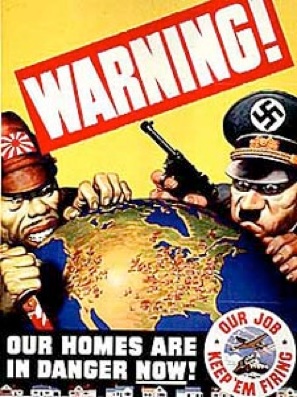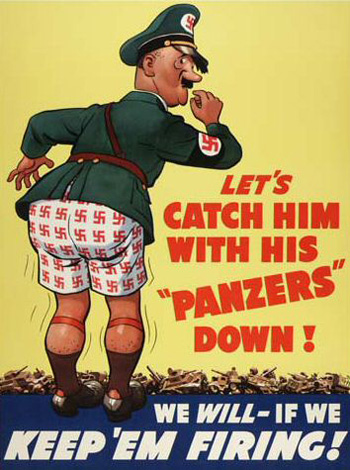Was the use of propaganda posters ethical during the War? Were these acceptable, or did they go too far?


The two posters you attached are more informational and motivational than serious Propaganda. As to their use being ethical, I personally say very much so. I will also say the certain Posters from Germany during WW II went way too far, and in the present day (from a U.S. point of view) be illegal to produce, or display. In particular a poster very graphically showing a very young German Female after having been attacked, and then killed by several slavering Red Army soldiers. The image was deleted from the photo side as presently it falls within the definition of kiddy porn. (not to mention being unconscionably rude, and distasteful) In general, each series of posters from all sides have to be assessed separately.
I’ve never seen that poster you’re referring to. But it does sound like it is a little bit over the top, and of the unacceptable variety.
It was, these were made by a fellow named Herbert Smagon, Google images for his posters, though even the internet will not show some of them.
Never heard of or saw works of Herbert Smagon before.
Googled it…and learned about your examples.
Then, WHO is Herbert Smagon ?
No pictures, no proper wiki entree. Except this:
Herbert Smagon (Lebensrune.png 2. Januar 1927 in Karwin in Ostschlesien) ist ein deutscher Künstler.
So, not died yet. (Hence the Dresden 1945-1989 poster…which , is weird , to link the 2 …if you are supposedly a cleaned german democrat…).
So , given 1945; he is aged less than 18…and gifted with a drawing talent…but limited to the “crying gipsy” kids and this typical german baked miniature puppets style children.
At 18, full in Hitler Youth upbringing, facing or hearing about all the 1945 horrors…unfamiliar what the Nazis did in 1939-1944 on all fronts.
Oh and mit 16 Jahren in die Akademie der bildenden Künste in Wien aufgenommen.
Vienna. Not germany. Vienna is also telling (the deeper in the high mountains, the more nazisentiment)
Yeah.
I can see that he might draw such paintings in 1945.
But in the after years ?
Also telling : 1947 wurde er als Reichsdeutscher aus Österreich vertrieben.
That’d be the first.
(oh a selfportrait: http://de.metapedia.org/wiki/Datei:Smagon.jpg )
Never heard of or saw works of Herbert Smagon before.
Googled it…and learned about your examples.
Then, WHO is Herbert Smagon ?
No pictures, no proper wiki entree. Except this:
Herbert Smagon (Lebensrune.png 2. Januar 1927 in Karwin in Ostschlesien) ist ein deutscher Künstler.
So, not died yet. (Hence the Dresden 1945-1989 poster…which , is weird , to link the 2 …if you are supposedly a cleaned german democrat…).
So , given 1945; he is aged less than 18, the formative years, …and gifted with a drawing talent…but limited to the “crying gipsy” kids and this typical german baked miniature puppets style children.
At 18, full in Hitler Youth upbringing, facing or hearing about all the 1945 horrors…unfamiliar what the Nazis did in 1939-1944 on all fronts.
Oh and mit 16 Jahren in die Akademie der bildenden Künste in Wien aufgenommen.
Vienna. Not germany. Vienna is also telling (the deeper in the high mountains, the more nazisentiment)
Yeah.
I can see that he might draw such paintings in 1945.
But in the after years ?
Also telling : 1947 wurde er als Reichsdeutscher aus Österreich vertrieben.
That’d be the first.
(oh a selfportrait: http://de.metapedia.org/wiki/Datei:Smagon.jpg )
His illustrations were luridly graphic in most cases, more so even than the old Tops trading cards Mars Attacks, and the set based on the American Civil War.
Smagon, as far as I can determine, is essentially a postwar artist who seems to have been obsessed with violent, lurid images of war and atrocity conceived from a Nazi/German viewpoint. Where this obsession came from I am not sure. In any event, it tends to be strong stuff. There are some examples on the photo side, I think.
Regarding the use of propaganda posters in general, and of whether “they were acceptable, or went too far”, I would have to ask whether it was realistic, in the context of a war in which civilians were killed in droves by bombing, ethnic cleansing, abuse by field forces and so on, to talk of whether propaganda posters (even extreme ones) can be judged as “acceptable” or “going too far”. Pure propaganda posters (and to a lesser extent public information posters - the two categories tend to blur into each other) were weapons of war, as much as were bombs, bullets and bayonets. When the dogs of war are really loosed, questions of taste (or modern political correctness) go out the window as far as “intellectual warfare” is concerned. It is part of the worthy, if fatuous, concern in the current era that war should be moderated by law - it will never happen. Even since WW2, there have been endless examples that relying on the “laws of war” to produce “civilized wars” is in vain. Better to remember that war’s “glories are all moonshine … war is Hell”. (W.T. Sherman). Best regards, JR.
